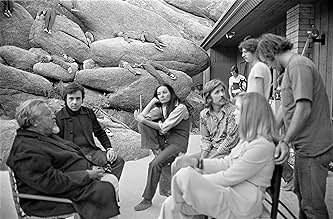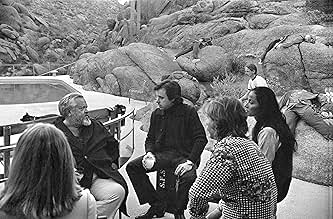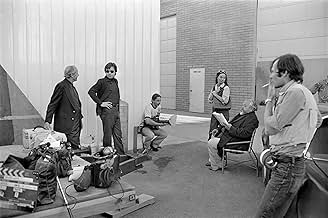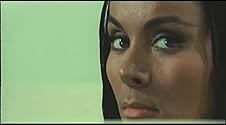NOTE IMDb
6,7/10
8,4 k
MA NOTE
Un réalisateur hollywoodien émerge de semi-exil avec l'intention de terminer son travail sur un film innovant.Un réalisateur hollywoodien émerge de semi-exil avec l'intention de terminer son travail sur un film innovant.Un réalisateur hollywoodien émerge de semi-exil avec l'intention de terminer son travail sur un film innovant.
- Réalisation
- Scénario
- Casting principal
- Récompenses
- 9 victoires et 8 nominations au total
Robert Random
- John Dale
- (as Bob Random)
Avis à la une
The Other Side of the Wind is not a perfect film, but perhaps the perfect film to punctuate Orson Welles' incredible and monolithic career, and certainly the most appropriate film to leave unfinished due to difficulty in production. Or perhaps it is the genius of Welles to have left the film unfinished on purpose?
The film focuses on "the man, the myth, the legend" type J.J. Hannaford, who is making his comeback film after a long hiatus of being out of touch with the modern movie realm. He celebrates his birthday by having a documentary team, friends, associates, and others join him for a showing of his new film "The Other Side of the Wind" starring his striking new lead actor Johnny Dale and lead actress (who is nameless according to the bill). What ensues is a chaotic, fast-paced bombardment of quick edits, snappy dialog, a movin' sound track, and fantastic camera-work sandwiched between the hypnotic, near-legato, orchestral moments of Hannaford's film "The Other Side of the Wind".
It took me about 25 min to get used to the faced-paced, almost bravado tone of the editing because I wanted more time to saturate the emotions and facial expressions of the characters. This is why I think the sections that show Hannaford's film stick out even more though; finally having time to "breath" (if you will) versus the zaniness of being in the business (reality). It even feels at times that Hannaford himself is drowning and just wants to breath. Even still, does Welles conduct an amazing performance from the grizzled-veteran John Huston, who nails the semi-pretentious over-indulgent Hannaford to a tee.
The highlights of Welles' last picture surely come from the technical aspects of the production, the anticipation born from it's long-troubled existence of coming to fruition, and the lead performance from Huston. I must say there are a handful of poignant, enigmatic scenes that truly hypnotize such as "The Other Side of the Wind"s rather incredible car scene, which for me was the true top moment of this feature. The camerawork changing from black and white to deep color is used to great effect as well.
I suppose we will never know if what we have today is truly Welles' vision fully intact, or just a shadow of what is was supposed to be. The Other Side of the Wind is definitely for any fans of Orson Welles and for those who enjoy seeing filmmaking done years ahead of its time. I feel like I must say that this film isn't getting praise from me simply because Welles' name is slapped on it, but good because there are a bunch of things to appreciate.
The film focuses on "the man, the myth, the legend" type J.J. Hannaford, who is making his comeback film after a long hiatus of being out of touch with the modern movie realm. He celebrates his birthday by having a documentary team, friends, associates, and others join him for a showing of his new film "The Other Side of the Wind" starring his striking new lead actor Johnny Dale and lead actress (who is nameless according to the bill). What ensues is a chaotic, fast-paced bombardment of quick edits, snappy dialog, a movin' sound track, and fantastic camera-work sandwiched between the hypnotic, near-legato, orchestral moments of Hannaford's film "The Other Side of the Wind".
It took me about 25 min to get used to the faced-paced, almost bravado tone of the editing because I wanted more time to saturate the emotions and facial expressions of the characters. This is why I think the sections that show Hannaford's film stick out even more though; finally having time to "breath" (if you will) versus the zaniness of being in the business (reality). It even feels at times that Hannaford himself is drowning and just wants to breath. Even still, does Welles conduct an amazing performance from the grizzled-veteran John Huston, who nails the semi-pretentious over-indulgent Hannaford to a tee.
The highlights of Welles' last picture surely come from the technical aspects of the production, the anticipation born from it's long-troubled existence of coming to fruition, and the lead performance from Huston. I must say there are a handful of poignant, enigmatic scenes that truly hypnotize such as "The Other Side of the Wind"s rather incredible car scene, which for me was the true top moment of this feature. The camerawork changing from black and white to deep color is used to great effect as well.
I suppose we will never know if what we have today is truly Welles' vision fully intact, or just a shadow of what is was supposed to be. The Other Side of the Wind is definitely for any fans of Orson Welles and for those who enjoy seeing filmmaking done years ahead of its time. I feel like I must say that this film isn't getting praise from me simply because Welles' name is slapped on it, but good because there are a bunch of things to appreciate.
Here it is, if anybody wants to see it.
Were you compelled by the character study of Citizen Kane? Were you thrilled by Touch of Evil? Then get ready for something unlike any of those or unlike anything. This is the mockumentary before Reiner or Guest, the improvisational dramedy before Apatow.
The entire point of this movie is that there's no point to this movie. Here is Orson Welles's most talked about movie about talking about a movie. His film about a film within a film. Orson Welles deliberately subverts Orson Welles to make an art film contained within an art film making fun of art films. John Huston plays John Huston playing Orson Welles as Orson Welles. Peter Bogdanovich plays himself as his own ripoff. There's a party celebrating a celebrated filmmaker making a film making fun of filmmakers. Nothing happens. So much happens. We learn everything about a legendary director about whom we learn nothing.
This film is a glimpse into the psyche of a filmmaker who wants to make films but has no idea how to keep making films. He wants to be commercially successful without compromising his integrity. He wants to make personal films for an impersonal audience. He wants to make something sexy despite being prudish. This movie isn't really for anyone; this movie is really for everyone.
It wasn't until the end of his life that Orson Welles realized the most important story he needed to tell was his own. It's a story whose only concern is that it was told, whether or not you like it. So watch it. Or don't. This movie doesn't care either way.
And if this review left you feeling confused, then I gave you an accurate impression of the film.
Were you compelled by the character study of Citizen Kane? Were you thrilled by Touch of Evil? Then get ready for something unlike any of those or unlike anything. This is the mockumentary before Reiner or Guest, the improvisational dramedy before Apatow.
The entire point of this movie is that there's no point to this movie. Here is Orson Welles's most talked about movie about talking about a movie. His film about a film within a film. Orson Welles deliberately subverts Orson Welles to make an art film contained within an art film making fun of art films. John Huston plays John Huston playing Orson Welles as Orson Welles. Peter Bogdanovich plays himself as his own ripoff. There's a party celebrating a celebrated filmmaker making a film making fun of filmmakers. Nothing happens. So much happens. We learn everything about a legendary director about whom we learn nothing.
This film is a glimpse into the psyche of a filmmaker who wants to make films but has no idea how to keep making films. He wants to be commercially successful without compromising his integrity. He wants to make personal films for an impersonal audience. He wants to make something sexy despite being prudish. This movie isn't really for anyone; this movie is really for everyone.
It wasn't until the end of his life that Orson Welles realized the most important story he needed to tell was his own. It's a story whose only concern is that it was told, whether or not you like it. So watch it. Or don't. This movie doesn't care either way.
And if this review left you feeling confused, then I gave you an accurate impression of the film.
Other reviews have shed light on the challenges and controversy surrounding the creation of this film, so I will not cover that. The initial scenes are haphazard, but after a short while, the plot adopts a firmer grasp. Some scenes were shot in b/w, and other in color, and the mix of the various film stocks does work, for the most part. Shrewd, biting humor infuse the entire film, which skewers the Hollywood studio system and offers glimpses of hangers-on, while highlighting the sordid nature of fame.
Wonderful cast, with standout performances from Huston and Foster. Some of the the dialogue appeared improvised, and the energy was highly-charged. The upbeat jazz score by Michel Legrand was terrific. Overall, I enjoyed this wild ride. Even so, I wonder what would have happened if Welles would have had the funds to personally helm this film into full fruition? Did he genuinely intend for this film to be finished by someone else? What would have happened if it had been retained as a lengthy, experimental journey?
Wonderful cast, with standout performances from Huston and Foster. Some of the the dialogue appeared improvised, and the energy was highly-charged. The upbeat jazz score by Michel Legrand was terrific. Overall, I enjoyed this wild ride. Even so, I wonder what would have happened if Welles would have had the funds to personally helm this film into full fruition? Did he genuinely intend for this film to be finished by someone else? What would have happened if it had been retained as a lengthy, experimental journey?
Years ago I saw a documentary that included a scene from a never-released Orson Welles film, The Other Side of the Wind. It was remarkably modern, a kaleidoscopic, eccentric work that was surprising for someone Welles age.
It wasn't until 2020 that I learned the film had actually been pulled together and released.
The cinema-verite style is explained as the result of pulling together footage from various documentarians and journalists video. The film begins with various hangers on of a famous director traveling to his party while elsewhere an investor is watching footage from his current, unfinished film.
This is actually the weakest part of the movie. The individual scenes are confusing and the way they are intercut with the film-within-a-film just add to the confusion. Apparently Welles had rough-cut about half the movie by the time he died, and my suspicion is this first part was not part of that rough cut, since it's weaker. Just a guess.
The film-within-a-film seems to be a parody of trippy, avant-garde, 60s filmmaking. I take it as Welles' portrayal of an old director past his glory days trying to create something hip.
The movie gets its footing when the director's party starts. There is a lot of striking B&W footage cut in and John Huston as the director is a powerful force. The party is to screen his movie, such as it is, and while it is essentially a plotless bit of nonsense with tons of gratuitous nudity, it does have some striking imagery, such as a scene set in slatted shadows and another involving a beaded necklace.
The surrounding film doesn't have much story. It's mainly about the director charming or dueling with various characters who want something from him. Things are hinted but rarely spelled out.
Welles was a genius, so even his worst movies, like Mr. Arkadin, are splashed with brilliance. Other Side of the Wind has a remarkable style and is generally fascinating, but it's not always satisfying and the film-within-a-film takes up more time than it probably should have.
If you're a fan of Orson Welles, or just a fan of cinema, this is a must-see. Yes, the movie would have been more impressive if it had been released in the early 70s, when it was filmed, but even today in a world full of found-footage movies this is still remarkable.
It wasn't until 2020 that I learned the film had actually been pulled together and released.
The cinema-verite style is explained as the result of pulling together footage from various documentarians and journalists video. The film begins with various hangers on of a famous director traveling to his party while elsewhere an investor is watching footage from his current, unfinished film.
This is actually the weakest part of the movie. The individual scenes are confusing and the way they are intercut with the film-within-a-film just add to the confusion. Apparently Welles had rough-cut about half the movie by the time he died, and my suspicion is this first part was not part of that rough cut, since it's weaker. Just a guess.
The film-within-a-film seems to be a parody of trippy, avant-garde, 60s filmmaking. I take it as Welles' portrayal of an old director past his glory days trying to create something hip.
The movie gets its footing when the director's party starts. There is a lot of striking B&W footage cut in and John Huston as the director is a powerful force. The party is to screen his movie, such as it is, and while it is essentially a plotless bit of nonsense with tons of gratuitous nudity, it does have some striking imagery, such as a scene set in slatted shadows and another involving a beaded necklace.
The surrounding film doesn't have much story. It's mainly about the director charming or dueling with various characters who want something from him. Things are hinted but rarely spelled out.
Welles was a genius, so even his worst movies, like Mr. Arkadin, are splashed with brilliance. Other Side of the Wind has a remarkable style and is generally fascinating, but it's not always satisfying and the film-within-a-film takes up more time than it probably should have.
If you're a fan of Orson Welles, or just a fan of cinema, this is a must-see. Yes, the movie would have been more impressive if it had been released in the early 70s, when it was filmed, but even today in a world full of found-footage movies this is still remarkable.
A famed, and infamous, movie director, JJ Hannaford, dies in a car accident. He was about to release his latest movie and a documentary camera crew had been following him around in the days preceding his death. We see the events leading up to his death, the careers Hannaford destroyed, the enemies he made and his last film, The Other Side of the Wind.
Written and directed by the great Orson Welles, this movie has taken nearly 50 years to be released. Welles started shooting it in 1970 and by his death in 1985 it had not been released. Production issues and politics prevented this. Now, in 2018, Netflix has released it. Being a huge fan of Orson Welles, the thought of seeing his long-dormant final film released was an exciting one.
However, the final product is quite disappointing. It looks and feels unfinished, a mashup of random scenes. While watching I thought that this was due to the film being in an unedited state when Welles died and it was edited to the final version after his death. Turns out the final version had already been edited by Welles, so we can't blame Netflix's production team.
The film-within-a-film element was initially intriguing but is ultimately confusing. What is part of Hannaford's film and what is Welles's film? Are the pretentious, trippy, hippy sequences and the gratuitous nudity and sex scenes Welles trying to appeal to early-70s arty audiences or his take on the pretentiousness of modern movies?
I would like to think that one of the themes of the movie is the pretentiousness of Hollywood, so will give Welles the benefit of the doubt on the content. However, it does become a jarring, disconcerting experience when you have seemingly-gratuitous scenes like those thrown randomly into the movie.
This said, it is not all bad. Welles's take on Hollywood, its movies and the pretentiousness of the times is well directed (if, indeed, that was his aim. It's so difficult to tell). The mystery surrounding John Dale adds intrigue. The story of JJ Hannaford is interesting and John Huston is perfect in the role. He pretty much just had to play himself!
Even here, however, Welles overeggs the pudding. I would have been more engaged in the Hannaford story if there weren't so many scenes that added nothing to plot or character development. So many scenes that just take up space and so much long, pointless dialogue. There's no momentum to the movie at all and the ending is a damp squib.
Written and directed by the great Orson Welles, this movie has taken nearly 50 years to be released. Welles started shooting it in 1970 and by his death in 1985 it had not been released. Production issues and politics prevented this. Now, in 2018, Netflix has released it. Being a huge fan of Orson Welles, the thought of seeing his long-dormant final film released was an exciting one.
However, the final product is quite disappointing. It looks and feels unfinished, a mashup of random scenes. While watching I thought that this was due to the film being in an unedited state when Welles died and it was edited to the final version after his death. Turns out the final version had already been edited by Welles, so we can't blame Netflix's production team.
The film-within-a-film element was initially intriguing but is ultimately confusing. What is part of Hannaford's film and what is Welles's film? Are the pretentious, trippy, hippy sequences and the gratuitous nudity and sex scenes Welles trying to appeal to early-70s arty audiences or his take on the pretentiousness of modern movies?
I would like to think that one of the themes of the movie is the pretentiousness of Hollywood, so will give Welles the benefit of the doubt on the content. However, it does become a jarring, disconcerting experience when you have seemingly-gratuitous scenes like those thrown randomly into the movie.
This said, it is not all bad. Welles's take on Hollywood, its movies and the pretentiousness of the times is well directed (if, indeed, that was his aim. It's so difficult to tell). The mystery surrounding John Dale adds intrigue. The story of JJ Hannaford is interesting and John Huston is perfect in the role. He pretty much just had to play himself!
Even here, however, Welles overeggs the pudding. I would have been more engaged in the Hannaford story if there weren't so many scenes that added nothing to plot or character development. So many scenes that just take up space and so much long, pointless dialogue. There's no momentum to the movie at all and the ending is a damp squib.
Le saviez-vous
- AnecdotesThe movie was filmed between 1970 and 1976, with editing continuing into the 1980s. When he died in October 1985, Welles left behind nearly 100 hours of footage and a work print consisting of assemblies and a few edited scenes.
- GaffesIn one confrontational scene, Brooks Otterlake, who Gregory Sierra's character, Jack Simon, refers to as, "Kid", is simultaneously Peter Bogdanovich and Rich Little. This is small overlap is because Rich Little was originally cast as the black turtleneck wearing, voice imitating director, Brooks Otterlake. However Bogdanovich replaced him, and Little's part was reduced to that of a Party Guest.
- Citations
[last lines]
Jake Hannaford: Who knows, maybe you can stare too hard at something, huh? Drain out the virtue, suck out the living juice. You shoot the great places and the pretty people... All those girls and boys. Shoot 'em dead.
- Crédits fousAfter the end credits, Hannaford's voice is heard saying "Cut"
- ConnexionsFeatured in AFI Life Achievement Award: A Tribute to Orson Welles (1975)
- Bandes originalesLes Délinquants
Written and performed by Michel Legrand
Published by WB Music Corp. o/b/o Productions,
Michel Legrand + Editions Royalty
Courtesy of Decca Records France
Under license from Universal Music Enterprises
Meilleurs choix
Connectez-vous pour évaluer et suivre la liste de favoris afin de recevoir des recommandations personnalisées
- How long is The Other Side of the Wind?Alimenté par Alexa
Détails
- Date de sortie
- Pays d’origine
- Site officiel
- Langues
- Aussi connu sous le nom de
- The Other Side of the Wind
- Lieux de tournage
- Sociétés de production
- Voir plus de crédits d'entreprise sur IMDbPro
- Durée2 heures 2 minutes
- Couleur
- Mixage
Contribuer à cette page
Suggérer une modification ou ajouter du contenu manquant





































